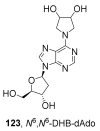Metabolism and DNA Adduct Formation of Tobacco-Specific N-Nitrosamines
- PMID: 35563500
- PMCID: PMC9104174
- DOI: 10.3390/ijms23095109
Metabolism and DNA Adduct Formation of Tobacco-Specific N-Nitrosamines
Abstract
The tobacco-specific N-nitrosamines 4-(N-nitrosomethylamino)-1-(3-pyridyl)-1-butanone (NNK) and N'-nitrosonornicotine (NNN) always occur together and exclusively in tobacco products or in environments contaminated by tobacco smoke. They have been classified as "carcinogenic to humans" by the International Agency for Research on Cancer. In 1998, we published a review of the biochemistry, biology and carcinogenicity of tobacco-specific nitrosamines. Over the past 20 years, considerable progress has been made in our understanding of the mechanisms of metabolism and DNA adduct formation by these two important carcinogens, along with progress on their carcinogenicity and mutagenicity. In this review, we aim to provide an update on the carcinogenicity and mechanisms of the metabolism and DNA interactions of NNK and NNN.
Keywords: DNA adducts; NNK; NNN; metabolism; tobacco-specific N-nitrosamines.
Conflict of interest statement
The authors declare no conflict of interest.
Figures













Similar articles
-
DNA adduct formation from tobacco-specific N-nitrosamines.Mutat Res. 1999 Mar 8;424(1-2):127-42. doi: 10.1016/s0027-5107(99)00014-7. Mutat Res. 1999. PMID: 10064856 Review.
-
An update on the formation in tobacco, toxicity and carcinogenicity of N'-nitrosonornicotine and 4-(methylnitrosamino)-1-(3-pyridyl)-1-butanone.Carcinogenesis. 2024 May 19;45(5):275-287. doi: 10.1093/carcin/bgae018. Carcinogenesis. 2024. PMID: 38437625 Free PMC article. Review.
-
Exposure and Metabolic Activation Biomarkers of Carcinogenic Tobacco-Specific Nitrosamines.Acc Chem Res. 2016 Jan 19;49(1):106-14. doi: 10.1021/acs.accounts.5b00472. Epub 2015 Dec 17. Acc Chem Res. 2016. PMID: 26678241 Free PMC article.
-
Identification of an N'-Nitrosonornicotine-Specific Deoxyadenosine Adduct in Rat Liver and Lung DNA.Chem Res Toxicol. 2021 Apr 19;34(4):992-1003. doi: 10.1021/acs.chemrestox.1c00013. Epub 2021 Mar 11. Chem Res Toxicol. 2021. PMID: 33705110 Free PMC article.
-
It is time to regulate carcinogenic tobacco-specific nitrosamines in cigarette tobacco.Cancer Prev Res (Phila). 2014 Jul;7(7):639-47. doi: 10.1158/1940-6207.CAPR-14-0095. Epub 2014 May 7. Cancer Prev Res (Phila). 2014. PMID: 24806664 Free PMC article.
Cited by
-
CYP2A6 Activity and Cigarette Consumption Interact in Smoking-Related Lung Cancer Susceptibility.Cancer Res. 2024 Feb 15;84(4):616-625. doi: 10.1158/0008-5472.CAN-23-0900. Cancer Res. 2024. PMID: 38117513 Free PMC article.
-
Association of Dietary Nitrate, Nitrite, and N-Nitroso Compounds Intake and Gastrointestinal Cancers: A Systematic Review and Meta-Analysis.Toxics. 2023 Feb 17;11(2):190. doi: 10.3390/toxics11020190. Toxics. 2023. PMID: 36851064 Free PMC article. Review.
-
Carcinogenic components of tobacco and tobacco smoke: A 2022 update.Food Chem Toxicol. 2022 Jul;165:113179. doi: 10.1016/j.fct.2022.113179. Epub 2022 May 25. Food Chem Toxicol. 2022. PMID: 35643228 Free PMC article. Review.
-
Can pristine/modified graphene repair N7-methylated guanine lesions? A DFT study.J Mol Model. 2025 Jun 23;31(7):196. doi: 10.1007/s00894-025-06419-3. J Mol Model. 2025. PMID: 40549068
-
Mass Spectrometric Quantitation of N'-Nitrosonornicotine-1N-oxide in the Urine of Cigarette Smokers and Smokeless Tobacco Users.Chem Res Toxicol. 2022 Sep 19;35(9):1579-1588. doi: 10.1021/acs.chemrestox.2c00195. Epub 2022 Aug 25. Chem Res Toxicol. 2022. PMID: 36006857 Free PMC article.
References
-
- Islami F., Goding Sauer A., Miller K.D., Siegel R.L., Fedewa S.A., Jacobs E.J., McCullough M.L., Patel A.V., Ma J., Soerjomataram I., et al. Proportion and number of cancer cases and deaths attributable to potentially modifiable risk factors in the United States. CA Cancer J. Clin. 2018;68:31–54. doi: 10.3322/caac.21440. - DOI - PubMed
Publication types
MeSH terms
Substances
Grants and funding
LinkOut - more resources
Full Text Sources
Miscellaneous

